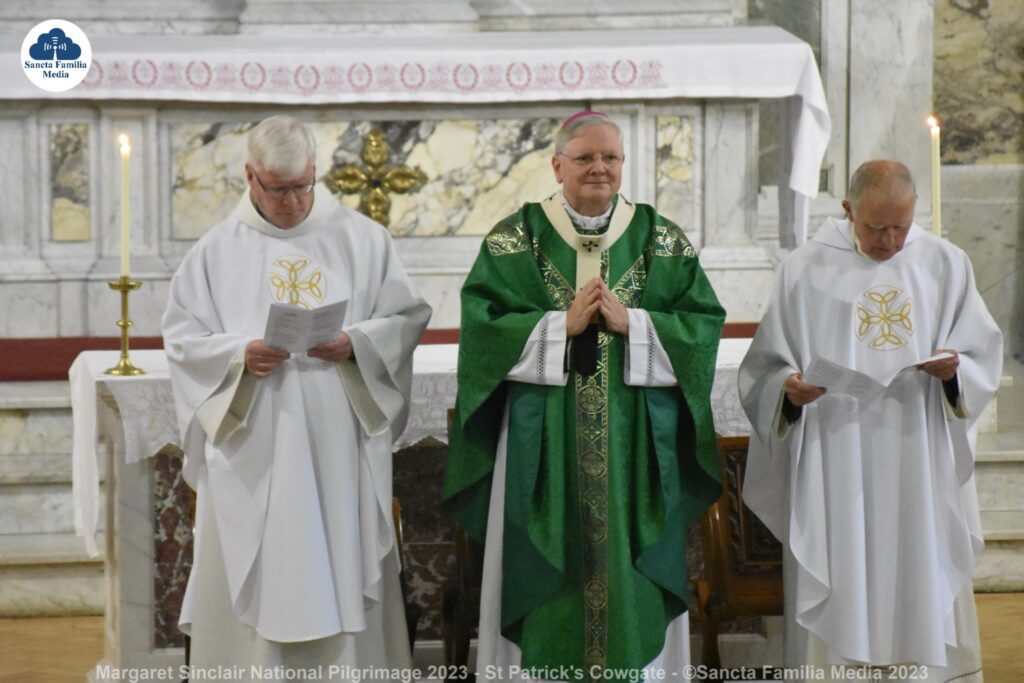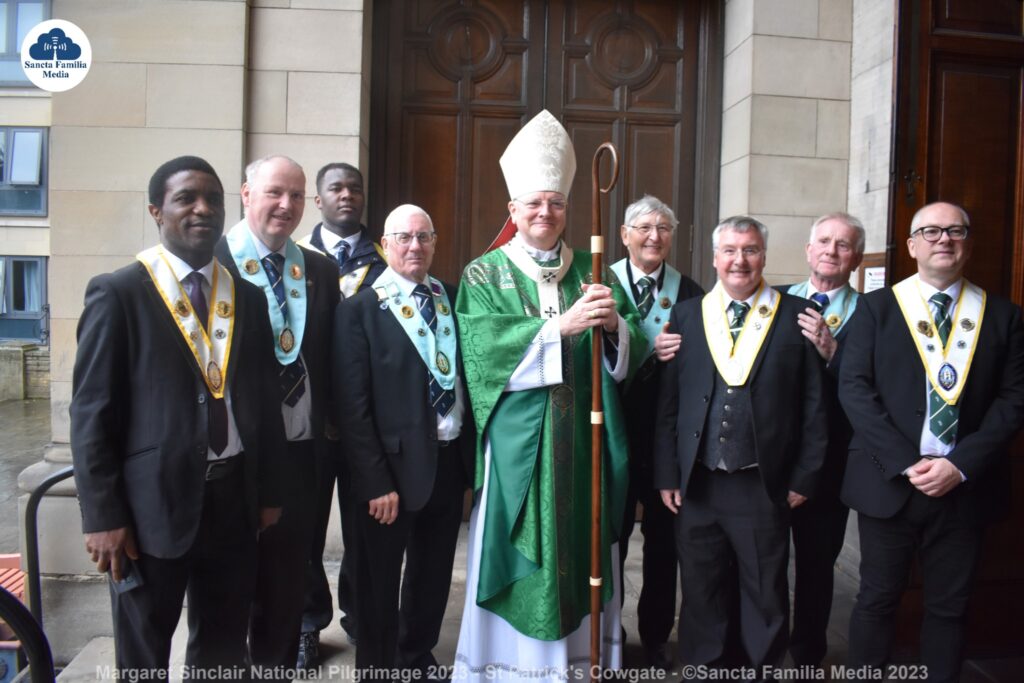Venerable Margaret Sinclair Pilgrimage
This annual event takes place at St Patrick's in The Cowgate, Edinburgh, on Sunday 21 September 2025. This year we mark the centenary of her death. Schedule to follow.
This annual event takes place at St Patrick's in The Cowgate, Edinburgh, on Sunday 21 September 2025. This year we mark the centenary of her death. Schedule to follow.
St Patrick’s in Edinburgh celebrates its 250th anniversary as a Christian Church on Wednesday (9 October 2024).
Vespers will be held at the church, in the city's Cowgate, at 6:00pm and Archbishop Cushley will give a homily, before a reception at St Cecilia's Hall in Niddrie Street
Fr Gerard Hatton, Administrator of the Church, said: “We are really looking forward to the event on 9 October and so pleased to be able to welcome back the other denominations who have also played a part in the life of the Church.
It is so important to give thanks to God and celebrate such an occasion.
The Church holds a very special place in the affections of Catholics both in the City and beyond. Many Clergy have served the parish over the years and many people still regard St Patrick’s as their spiritual home.”
“Fr Gerard, along with Fr Ninian Doohan, arrived at St Patrick's last year, at the invitation of Archbishop Cushley, to work on the Edinburgh Oratory Project.
When the 'square style' church opened in 1774 it was Episcopalian and known as St Paul’s Chapel.
The great and the good of the day worshipped here with a Congregation of more than 1,000.
The writer and diarist James Boswell said:“It was striking to see so grand a place of worship in Edinburgh”.
The Congregation commissioned several religious art works by the Scottish artist, Alexander Runciman, one of the most distinguished painters of the day, to decorate the Apse.
Many of the well to do congregation started to move into the plusher New Town of the city, and in 1818 the Chapel was sold to a Presbyterian Congregation, the Scottish Relief Church.
They made changes to the interior overpainting the mural of the Ascension on the ceiling of the Apse (the Runciman Trust has been established to oversee the restoration of the mural as funds become available) and replaced the Altar with a pulpit.
The next few years were an unsettled period, factions emerged, and they ran into financial difficulties.
When the congregation decided to move out of the Church they agreed to sell their redundant building to the Catholic Church.
At that time, Bishop James Gillis knew he had to do something to meet the spiritual needs for the growing number of Irish immigrants who had arrived in Edinburgh to escape the famine.
The Catholic population had risen from 1,000 to 14,000 and the old St Patrick’s in Lothian Street had become inadequate for the many who had settled in the insanitary and disease-ridden slum area of the Cowgate.
The new church cost £4,300. Half was paid for by the Church, the rest by the people.
They may have lived in poverty but were determined to raise money for a church of their own.
The new Church, dedicated to St Patrick, was officially opened on Sunday 3 August 1856.
The congregation present for the opening Mass was estimated at 2,600.
It became a vibrant parish. At its busiest there were more than 600 baptisms a year.
The parish has the honour of being the first St Vincent de Paul Society in Scotland.
The Church became a hub for those living in Edinburgh who were enduring much bigotry and alienation from the local community.
Many met their future husbands and wives there as it was a great place for socialising!
The Cowgate became known as “Little Ireland” and still is to this day.
One of the Priests, Limerick-born Canon Edward Hannan, worked tirelessly for the souls under his care and was committed to the youth of the parish.
In 1869, he introduced the Catholic Young Men’s Society (CYMS).
It was from their meeting place in the nearby St Mary’s Halls that he, and a young Irish Parishioner, Michael Whelahan, suggested forming a football team to promote the physical wellbeing of these young men.
Players had to be practising Catholics and members of the CYMS.
𝐇𝐢𝐛𝐞𝐫𝐧𝐢𝐚𝐧 𝐅𝐂 formed in the St.Patrick's Church, Cowgate area of Edinburgh in 𝟏𝟖𝟕𝟓
This area had a high number of 𝐈𝐫𝐢𝐬𝐡 immigrants, hence the harp on the shirt & the clubs motto at the time 'Erin Go Bragh' (Ireland forever)
𝐂𝐚𝐧𝐧𝐨𝐧 𝐄𝐝𝐰𝐚𝐫𝐝… pic.twitter.com/2WqqqpUaHG
— Hibernian Retro (@HibernianRetro) March 17, 2024
And so Hibernian Football Club, with the Harp as its crest, was founded on 6 August 1875, joining the Edinburgh Football Association in 1876 and the Scottish Football Association not long afterwards.
They found a permanent home at Hibernian Park on Easter Road in 1880 and went on to win the Scottish Cup in 1888.
A bust of Canon Hannan can be found at Hibernian’s Easter Road Stadium and a Memorial to him is kept in the entrance of St Patrick’s.
Many fine people have passed through the great doors of the Church, good living people who strive to support the church in many ways as well as those who have made their mark not just in Edinburgh but across the world.
It was in St Patrick’s that James Connolly, born of Irish parents, was baptised, Leaving St Patrick’s School at aged 10 he eventually joined the British Army which he came to despise.
He left for Ireland, became involved in politics, formed the Irish Labour Party becoming a commander in the Irish Republican movement.
For his part in the Easter Uprising, he was court marshalled and was executed in front of a firing squad on 12 May 1916.
St Patrick’s is also fortunate to have one of its former parishioners on the road to being declared a Saint.
The Venerable Margaret Sinclair was taught and received her Sacraments in the Church.
Her remains lie in the Sacred Heart Altar and many thousands of pilgrims bring their petitions and prayers to her.
The annual Margaret Sinclair Pilgrimage is a national event at the Church each September.
Article (abridged) by Uriel Jamieson, published in the Irish Voice, September 2024.
People gathered at St Patrick's Church in The Cowgate, Edinburgh, for the Annual Margaret Sinclair Pilgrimage.
It was is a time of prayer, stillness and reflection to ask for her intercession and that she may be Scotland's next 'blessed'.
The day featured blessings at the shrine of Margaret, talks, and a presentation frmm pupils at Sinclair Academy, Winchburgh.
The day concluded with Mass, with Archbishop Cushley as the principal celebrant. View the Sancta Familia video on Facbook here.









Find out more about Venerable Margaret Sinclair at https://www.margaretsinclair.scot/
People gathered at St Patrick's in Edinburgh on Sunday for the Annual National Venerable Margaret Sinclair Pilgrimage.

The event is to pray for the beatification of Margaret Sinclair (1900-1925), a woman who grew up in the Cowgate and attended St Patrick's Church.

Margaret displayed an example of holiness amid the ordinariness of working class life. Read her story here.

The tomb of the nun is located at the Church and each year people from across Scotland gather to pray there.

Pope Paul VI declares that Margaret practised the Christian virtues to a heroic degree and she was given the title: ‘The Venerable Margaret Sinclair’.

In 2015 Archbishop Cushley relaunched the campaign to beatify Venerable Margaret and appointed Fr Joseph McAuley of the Archdiocese of Glasgow to be his Episcopal Delegate for the Promotion of the Cause of Venerable Margaret Sinclair.

The Pilgrimage included a Holy Hour, a reflection, benediction and Mass celebrated by Archbishop Cushley.

All pictures: Sancta Familia Media.